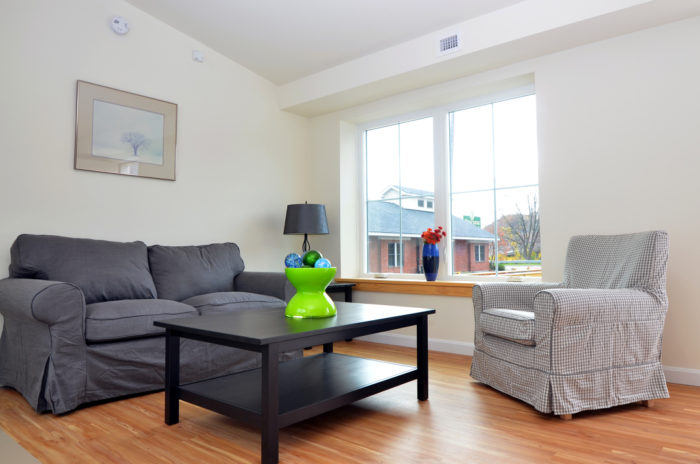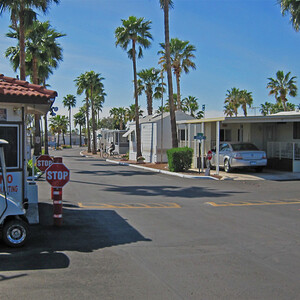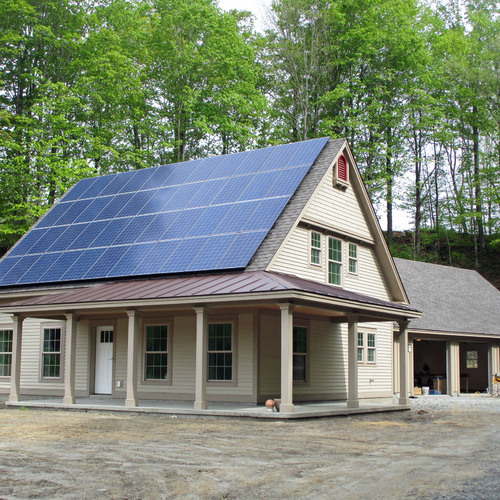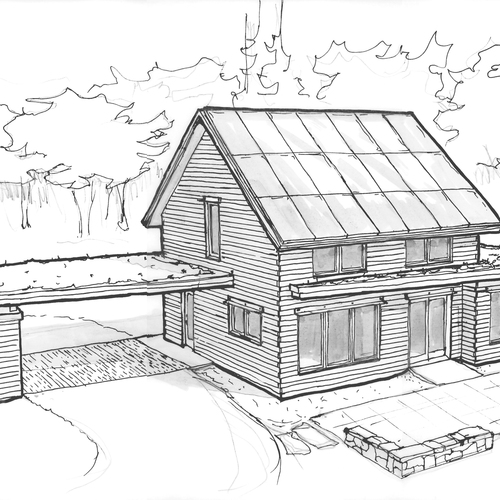
Image Credit: Andrew Gimino Photography
Image Credit: Andrew Gimino Photography Home tour. The first of 10 high-performance mobile homes drew a crowd for an open house in White River Junction, Vermont.
Image Credit: Andrew Gimino Photography Mobile homes that make sense. The prototype of a high-performance mobile home has double-stud walls and triple-glazed windows. It will use an estimated 71% less energy than a standard mobile home.
Image Credit: Manufactured Housing Innovation Project Mobile or modular? The 70-ft. long home looks like a mobile home, but its manufacturer calls it a high-performance modular with features that put most stick-built houses to shame.
Image Credit: Andrew Gimino Photography Heating, cooling and ventilation: A CERV unit combines an air-source heat pump and a continuously operating energy recovery ventilator. The system monitors humidity, carbon dioxide and volatile organic compounds and adjusts itself according to need. The blue and red PEX tubing is for domestic hot water.
Image Credit: Andrew Gimino Photography
UPDATED on November 6, 2013 with information on the design team
A high-performance mobile home that will use a fraction of the energy of standard manufactured housing and rival the energy efficiency and quality of advanced stick-built homes has made its public debut in Vermont.
The first of 10 mobile homes to be produced under the Manufactured Housing Innovation Project was unveiled Oct. 23 in White River Junction, Vermont. The “single-wide” mobile homes, roughly 14 ft. wide and either 66 ft. or 70 ft. long, have features common for high-performance houses but virtually unheard of in manufactured housing: double stud walls, triple-glazed windows, and more than a foot of blown-in insulation in the roof.
The project to develop this new type of mobile home is a response to Tropical Storm Irene, which brought widespread damage to Vermont in 2011. Although mobile homes make up just 7% of the state’s housing stock, they represented 15% of the homes damaged in the storm, according to the Vermont Housing & Conservation Board (VHCB).
The year after Irene barreled through the state, VHCB, with help from the High Meadows Fund and others, launched an effort to improve mobile home design. They were prompted not only by the disproportionate storm damage but also by two studies published in 2012 that showed people who live in mobile homes pay a lot more for energy than do those who live in stick-built houses.
A working group of two dozen or more people joined the effort. Vermod High Performance Manufactured Housing in White River Junction is building them. The houses were designed by Pill-Maharam Architects of Shelburne, VT, in collaboration with Vermod.
“This ain’t no mobile home,” Vermod General Manager Chet Pasho said by telephone. “It just looks like one at 50 miles an hour going down the road. This is a high-performance modular home that right how we’re building on mobile home geometry.”
Unusual features for a mobile home
VHCB said in a report on the project that the U.S.Department of Housing and Urban Development first developed standards for manufactured housing in the mid-1970s. They’ve been updated several times since then, but mobile homes still put their occupants at a big energy disadvantage and they’ve long been disparaged as poorly built.
“Replacing poor quality but very inexpensive homes with homes of better quality that cost more must be considered in the context of the fact that nationally 41% of mobile home-dwellers have incomes below 50% of the area median,” the VHCB says.
The prototype includes features that plenty of conventional stick-built houses still don’t have:
- Double 2×4 walls on 24-in. centers creating 10-in. wall cavities insulated to R-43 with blown-in fiberglass insulation.
- 5/8-in. gypsum wallboard on the interior glued to the studs.
- 5/8-in. Zip System roof sheathing covered with Grace Ice & Water Shield.
- Roof trusses 24 in. on center with 14 in. of blown-in fiberglass (R-60), plus a floor system insulated to R-44 and sealed with Zip System sheathing and tape.
- A Conditioning Energy Recovery Ventilator, or CERV that combines an air-source heat pump with a ventilation system that monitors carbon dioxide, humidity, and volatile organic compounds in the air and adjusts ventilation rates as needed.
- Triple-glazed awning and casement windows manufactured by PVC Industries.
- A heat-pump water heater.
This new breed of mobile home isn’t cheap; the homes cost roughly $100,000 each. But, says VHCB, energy accounts for nearly half of monthly housing costs in a conventional HUD-certified mobile home but should total only 16% in a high-performance model.
Renewable energy systems strongly recommended
With the addition of a rooftop photovoltaic array, this type of the house is designed for net-zero energy operation, says Peter Schneider, a senior energy consultant with Efficiency Vermont, which provides energy efficiency services for Vermont ratepayers and took part in the pilot program.
An array of up to 5.5 kW in capacity can be installed on a home 66 ft. long, and 6 kW systems can be installed on a 70-ft. model, Schneider says. That’s about all these roofs will hold, but it should be enough for net-zero operation, and reduce monthly power bills to the service charge alone.
“You’re going from a conventional mobile home that is looking at $200 to $300 a month for their total energy costs and taking it down to $16 a month if they put the PV on it,” Pasho said, adding that the quality of construction also is much higher than a conventional mobile home.
“For this project we’re working with the state and building them as single module homes with the configuration of a traditional mobile home because they’re designed to be replacement homes in [mobile home] parks,” he said. “You can’t come in and put a nice ranch in there because the park layout is for sausages.”
Schneider said a blower-door test of the first unit showed air leakage of 0.9 air changes per hour at 50 pascals of pressure. Once the units are set on their sites and all penetrations for utilities are sealed, the results might be somewhat better. Air leakage rates also may be reduced as Vermod crews gain more experience.
The HERS rating will be in the single digits, Schneider said, with the exact number still to be determined based on values allowed for the CERV unit.
In all, Pill-Maharam designed one-, two- and three-bedroom models, including one that is ADA-compliant. Pill said the goal was to make the buildings as space- and energy-efficient as possible while keeping them aesthetically pleasing and low in cost.
People in many states could benefit
Improved air quality and energy efficiency would be a big boost in Vermont, where winters are long and common fossil fuels like oil and kerosene are expensive. But Vermont is actually in the middle of the pack in terms of the percentage of total housing represented by mobile homes. The U.S. Census bureau says 6.9% of all Vermont houses were mobile homes in 2008.
Elsewhere, the fraction is much higher. The top three states are South Carolina (17.9%), New Mexico (16.4%) and Mississippi (15.2%). And if Vermont’s case is any guide, lots of these mobile homes are showing serious signs of age.
“Over 22% of mobile homes in Vermont are pre-1976, the year that the HUD standards went into effect,” the VHCB report says. “These homes are aging out and will need to be replaced with something. Having a super-energy efficient alternative is an important option.
“In addition, 45% of Vermont’s mobile home or manufactured housing stock is pre-1990. Although a 25-year-old home is not particularly old if it is stick built, some manufactured homes of this vintage are also beginning to show signs of significant deterioration.”
One big problem is how buyers with low incomes will be able to afford $100,000 mobile homes. Although buyers for these first high-performance homes will be eligible for subsidies, a used HUD- certified model can be had for as little as $8,000. Many mobile home park residents don’t have mortgages, and might not be interested or able in taking out a big loan for a new mobile home, no matter how energy efficient it might be.
Pasho says the $100,000 price tag does not include a foundation or utility hookups, but early buyers will get a helping hand from subsidies and loans that could bring the cost to as little as $35,000. That’s what the buyer of the first unit will pay.
Weekly Newsletter
Get building science and energy efficiency advice, plus special offers, in your inbox.














One Comment
we did this 3 years ago!
We built a home that exceeded energy star requirements and the local green building's highest score. Only 5% of home s built meet this high standard and we exceeded it by 33%. Yes It was a manufactured home and it was also done to look just like any home in the neighborhood. You can see some pictures here http://www.valleyhomedevelopment.com/custom-home-santacruz-800sqft and on our blog here http://www.backyardhomepros.com/?p=229
Log in or create an account to post a comment.
Sign up Log in